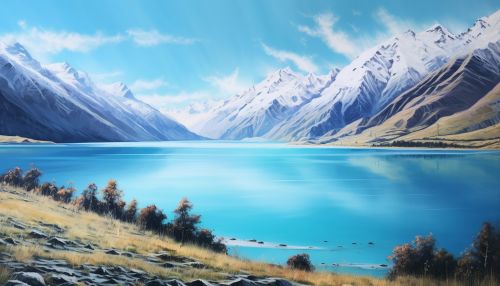Glacial lake
Formation
Glacial lakes are formed when a glacier erodes the land, and then melts, filling the hole or space that it has created. This process begins when a glacier moves over an area containing cracks in the bedrock. The glacier erodes the land by a process called glacial erosion, and as it moves, it carves out a large hole or basin in the earth. When the glacier retreats or melts, water fills the basin created, and a lake is formed. This process can take thousands of years, but the result is a body of water that can range in size from a small pond to a large lake.


Types of Glacial Lakes
There are several types of glacial lakes, including cirque lakes, tarns, and paternoster lakes.
Cirque Lakes
A cirque is a type of glacial lake that is formed in a cirque, a bowl-shaped valley high on a mountain. The cirque is carved out by a glacier, and when the glacier retreats, the cirque is often filled with water, forming a lake.
Tarns
A tarn is a type of glacial lake that is formed in a valley carved out by a glacier. Tarns are often found in cirques, or high mountain valleys. They are typically smaller than other types of glacial lakes, and are often circular in shape.
Paternoster Lakes
A paternoster lake is a type of glacial lake that is formed in a series of steps along a glacial valley. The term "paternoster" means "Our Father" in Latin, and is used to describe these lakes because they are often strung together like beads on a rosary. Each lake in the series is typically smaller than the one before it, and they are often connected by small streams or waterfalls.
Characteristics
Glacial lakes are often characterized by their clear, blue water. This is due to the large amount of rock flour, or finely ground rock and sediment, that is carried into the lake by melting glaciers. This rock flour is suspended in the water, and it reflects sunlight, giving the water its blue color.
Glacial lakes also often have a high mineral content. This is because glaciers grind up rock as they move, and this ground up rock is carried into the lake by meltwater. These minerals can give the water a milky appearance, and can also contribute to the lake's color.
Ecology
The ecology of glacial lakes is often unique, due to their cold temperatures and high mineral content. Many glacial lakes are oligotrophic, meaning they have low levels of nutrients. This can limit the types of plants and animals that can live in the lake. However, some species have adapted to these conditions, and glacial lakes can be home to a variety of fish, birds, and other wildlife.
Threats
Glacial lakes can pose a threat to human communities and infrastructure. This is due to a phenomenon known as a glacial lake outburst flood (GLOF). A GLOF occurs when the dam containing a glacial lake fails, causing a large amount of water to be released. This can cause flooding in areas downstream, and can lead to significant damage and loss of life.
